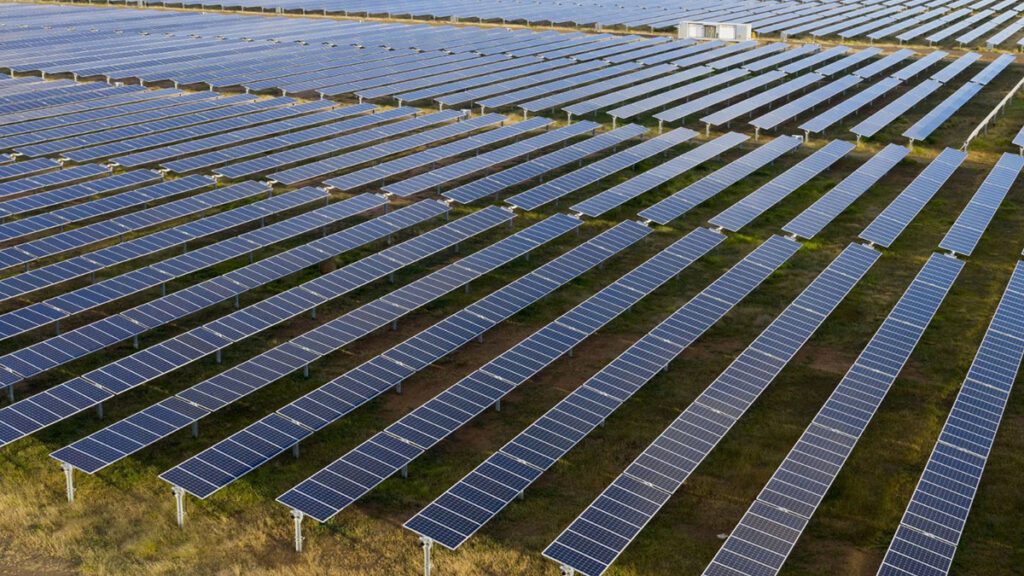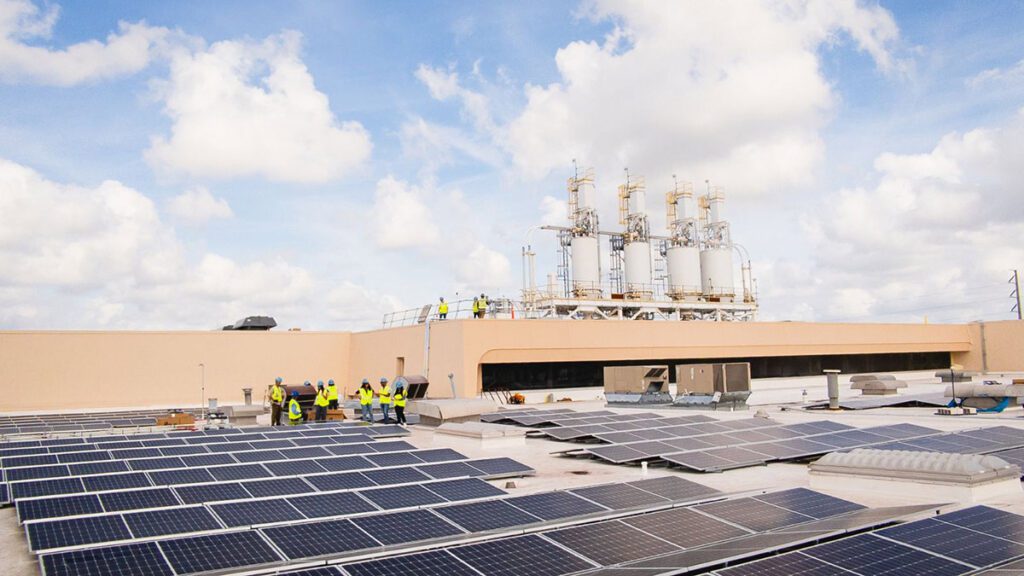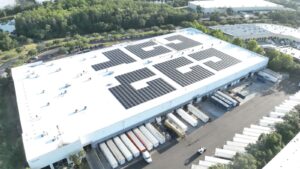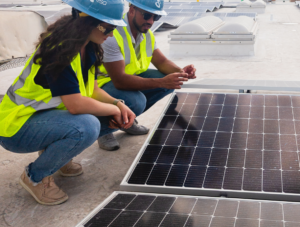Imagine a future where a company’s carbon footprint and scope 2 emissions reductions are achieved without sacrificing profits. Welcome to a world where your energy bill is no longer a liability but an asset that drives sustainable growth. A world where you are no longer at the mercy of fluctuating energy prices but harnessing the consistent and abundant power of the sun.
American businesses are uniquely positioned to champion this change, ushering your company into an era of responsible prosperity. This isn’t just a lofty vision—it’s a tangible reality made possible by commercial solar development.
Investing in solar energy not only helps your business reach impressive ESG (Environmental, Social, Governance) milestones, but it also secures long-term financial advantages, fostering resilience in an ever-evolving economic landscape. If you’re ready to align your financial ambitions with environmental stewardship, then it’s time to seriously consider solar as a viable business decision.
What is ESG?
ESG stands for Environment, Social, and Governance. Environmental factors include a company’s impact on the natural environment, such as its carbon footprint or use of natural resources. Social factors relate to how a company interacts with its stakeholders, including employees, customers, and communities.
Governance factors refer to a company’s internal management and control structures, such as the board of directors, executive pay, and shareholder rights.
Why is ESG on the rise?
Businesses are adopting sustainable business strategies as a result of a growing understanding that they must take the lead in solving a variety of environmental issues. As the years begin to pass by, companies now view sustainability as a strategic priority as they set themselves up for the future. Due to the impact of concerns like climate change and social justice on investors, ESG investing has gained prominence in recent years.
The momentum of ESG investing experienced a significant boost during the years of 2013 and 2014 when the first studies were published and clearly showed that companies with strong sustainability performance also had good financial results.

Scope 1, 2, and 3 emissions
Scope 1 Emissions
Scope 1 pertains to the emissions that directly enter the atmosphere as a result of the activities carried out by the company. To put it differently, these emissions of greenhouse gasses originate from the resources that are owned and managed by the company itself. This includes gas used in company cars and fuel used to power equipment.
Scope 2 Emissions
Scope 2 is purchased electricity. In other words, it is related to the emissions of greenhouse gasses caused indirectly through the consumption of electricity, steam, heat, and cooling in buildings and production processes.
Scope 3 Emissions
Scope 3 encompasses all additional emissions indirectly linked to a company’s operations both upstream and downstream. Scope 3 is generally the primary driver of a company’s carbon footprint as it encompasses factors such as:
- Business travel, such as air travel
- Employee travel to and from work
- Disposal of waste during operations
- Purchase of goods and services
- Transportation and distribution associated with suppliers and customers
- Capital assets, investments, and franchise operations
- Leased assets
- Emissions resulting from the use of a sold product or service
- The end-of-life stage of a product, when it is no longer useful
Scope 2 emissions offer significant opportunities for reduction via decarbonization as a service strategy. This concept involves engaging external experts to help design, finance, implement, and manage customized clean energy solutions that lead to carbon neutrality. A primary mechanism is the adoption of solar development strategies, which replace carbon-intensive energy sources with clean, renewable ones.
Why Target Scope 2 Emissions?
Scope 2 emissions typically constitute a large proportion of an organization’s carbon footprint and can be controlled directly through the choice of energy source. By partnering with a solar development business, companies can leverage cutting-edge technologies and expertise to transition to renewable energy.
Not only does this approach contribute towards ESG goals by reducing carbon emissions and combating climate change, but it also makes good business sense.
It can lead to energy cost savings over time, enhance corporate reputation, and position companies to better manage future regulatory risks around carbon emissions. Therefore, a ‘decarbonization as a service’ strategy targeting scope 2 emissions is both a sound environmental and business move.

Four Ways to Offset Scope 2 Emissions
Onsite solar:
Solar power has emerged as a highly effective solution for offsetting Scope 2 emissions for businesses. By generating electricity directly at the location where it is consumed, onsite solar systems eliminate the need for grid-supplied power, which often relies on fossil fuel-based sources.
Solar panels harness the abundant energy from the sun, converting it into clean and renewable electricity. This sustainable energy source effectively displaces the use of electricity generated from fossil fuels, reducing carbon dioxide emissions associated with Scope 2 emissions.
By adopting onsite solar, businesses and organizations can significantly mitigate their environmental impact, and decrease their reliance on non-renewable energy sources.
As an example, Kohls, a clothing manufacturer, collaborated with a US solar company, with the objective of installing solar panels in their stores back in 2007. As a result, reports suggest that 40% of Kohl’s stores now rely on solar-generated electricity.
Community Solar:
Community solar plays a crucial role in mitigating scope 2 emissions by offering a practical and accessible solution for individuals, businesses, and communities to transition towards cleaner energy.
Community solar refers to local solar installations that are shared by a number of community customers, each of whom receives a credit on their electricity bills for their share of the power produced. This model for solar energy is being rapidly adopted nationwide.
This gives businesses the ability to tap into the benefits of renewable energy without the need for costly infrastructure investments. They can align their sustainability goals with their energy consumption, offset their scope 2 emissions, and demonstrate their commitment to the environment by reducing their carbon footprint.
By participating in a community solar program, US businesses have the opportunity to benefit from solar energy and enjoy energy bill savings of 10-15%.
VPPA:
A Virtual Power Purchase Agreement (VPPA) is a financial contract that provides Renewable Energy Credits or Certificates (RECs) from a specific renewable energy project located off your company’s property. It is among one of the most powerful tools that businesses use to offset their scope 2 emissions.
By sourcing renewable energy through VPPAs, businesses effectively displace the use of fossil fuel-based electricity, which contributes to scope 2 emissions. A significant advantage of VPPAs is that they enable companies to promote the expansion of renewable energy without the need to personally handle the physical assets involved.
This is beneficial for companies lacking the help or resources required to develop and manage their own renewable energy projects.
VPPAs offer scalability and allow buyers to achieve a significant portion of their sustainability objectives through a limited number of agreements.
An example of this is Fifth Third Bank, which successfully achieved its 100% renewable energy goal through a single VPPA. This demonstrates the effectiveness of VPPAs in enabling buyers with widely distributed electricity loads or loads in regulated markets to swiftly offset their scope 2 emissions and fulfill their renewable energy objectives.
Renewable Energy Credits:
Renewable energy credits are intangible commodities that can be traded and serve as evidence that 1 MWh of electricity originated from a renewable energy source and was injected into the interconnected power grid for distribution.
RECs enable the transfer of the renewable aspects of renewable energy to the company, meaning that when you combine RECs with grid electricity, renewable energy is effectively being generated on your company’s behalf.
With these credits, a solar farm has the ability to sell its generated power to the grid while also selling credits associated with that power to corporations and other buyers. By purchasing these standalone credits, corporate buyers can declare that they have achieved their clean energy targets and have offset their scope 2 emissions.
Companies that have purchased RECs to help them pursue their ESG goals and lower their scope 2 emissions are Starbucks, Stapes, and Johson & Johnson. It is very common for huge corporations like the ones listed to participate in the buying of renewable energy credits.
Sources
- https://www.ey.com/en_us/sustainability/esg-evolution?WT
- https://www.forbes.com/sites/georgkell/2018/07/11/
- https://www.sustain.life/blog/
- https://greenly.earth/en-us/blog/company-guide/
- https://www.jabil.com/blog/scope-1-scope-2-emissions.html
- https://greenbusinessbureau.com/topics/carbon-accounting/
- https://www.energy.gov/eere/solar/community-solar-basic
- https://www.choosesolar.com/community-solar-for-business/
- https://sustainablesolutions.duke-energy.com/resources/
- https://www.linkedin.com/pulse
- https://www.53.com/content/fifth-third/en/media-center
- https://rmi.org/wp-content/uploads/2018/12/rmi-brc-intro-vppa.pdf
- https://www.seia.org/initiatives/community-solar
- https://watchwire.ai/











